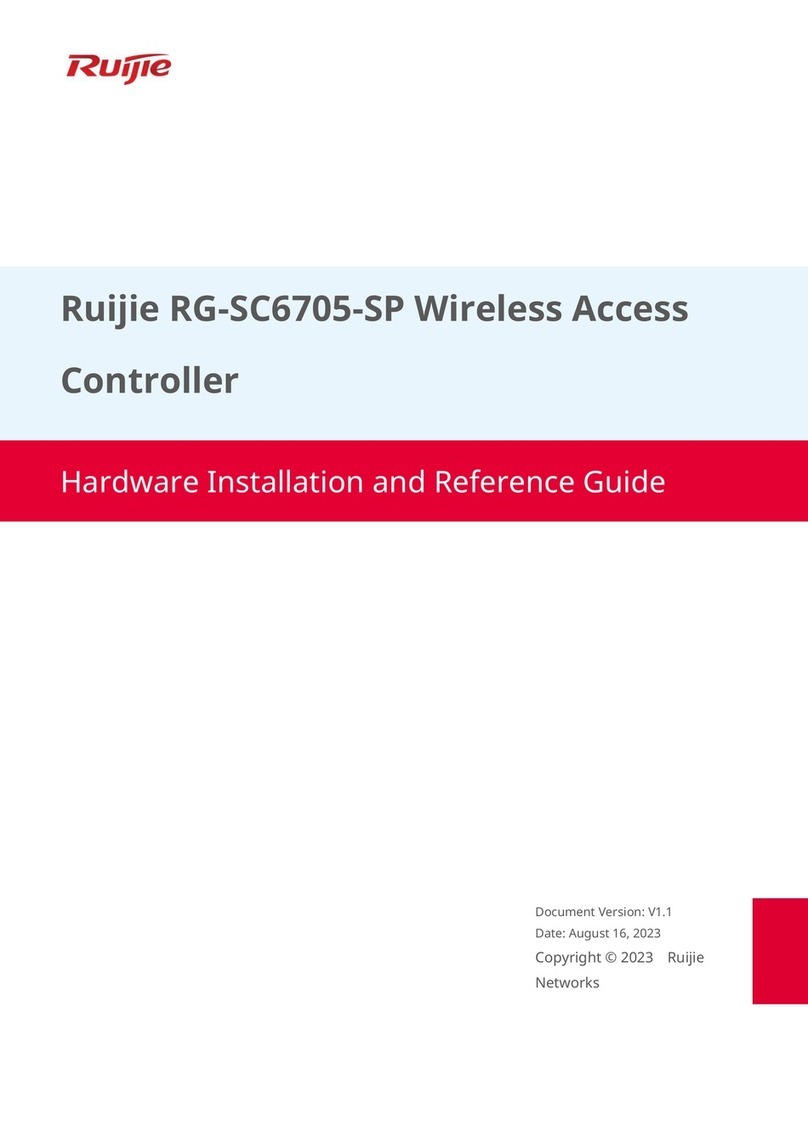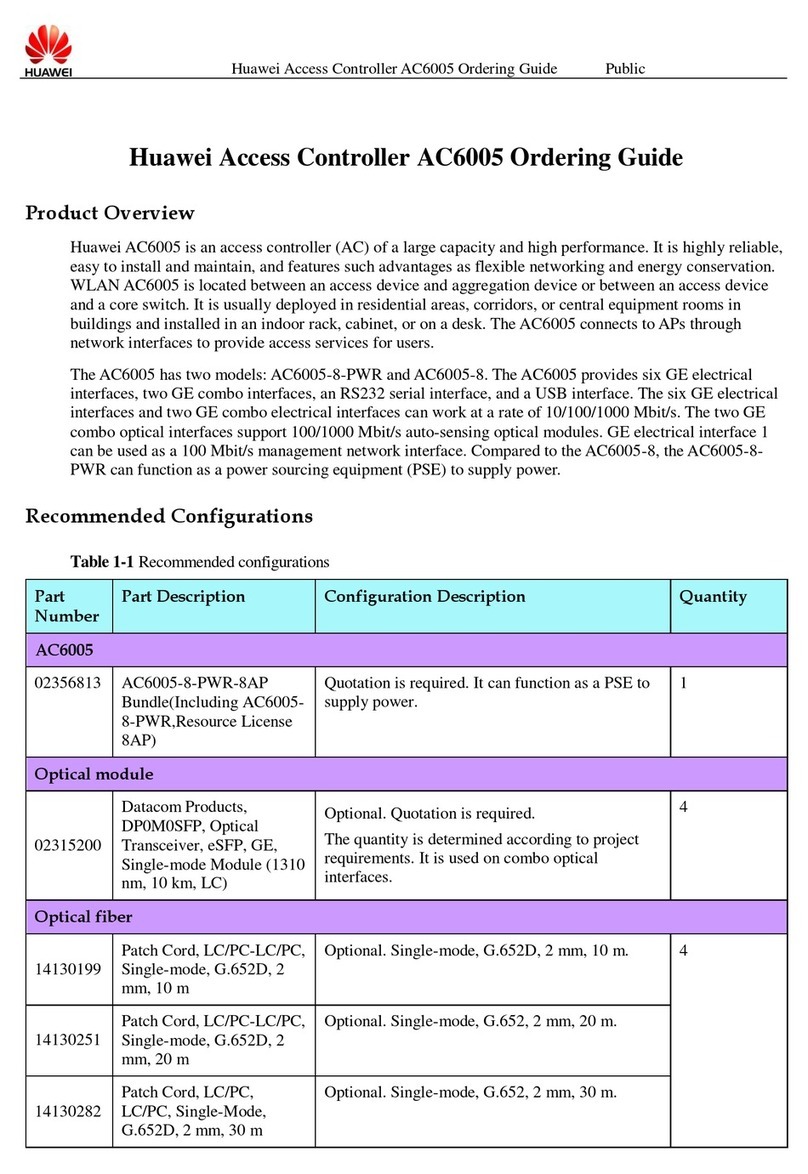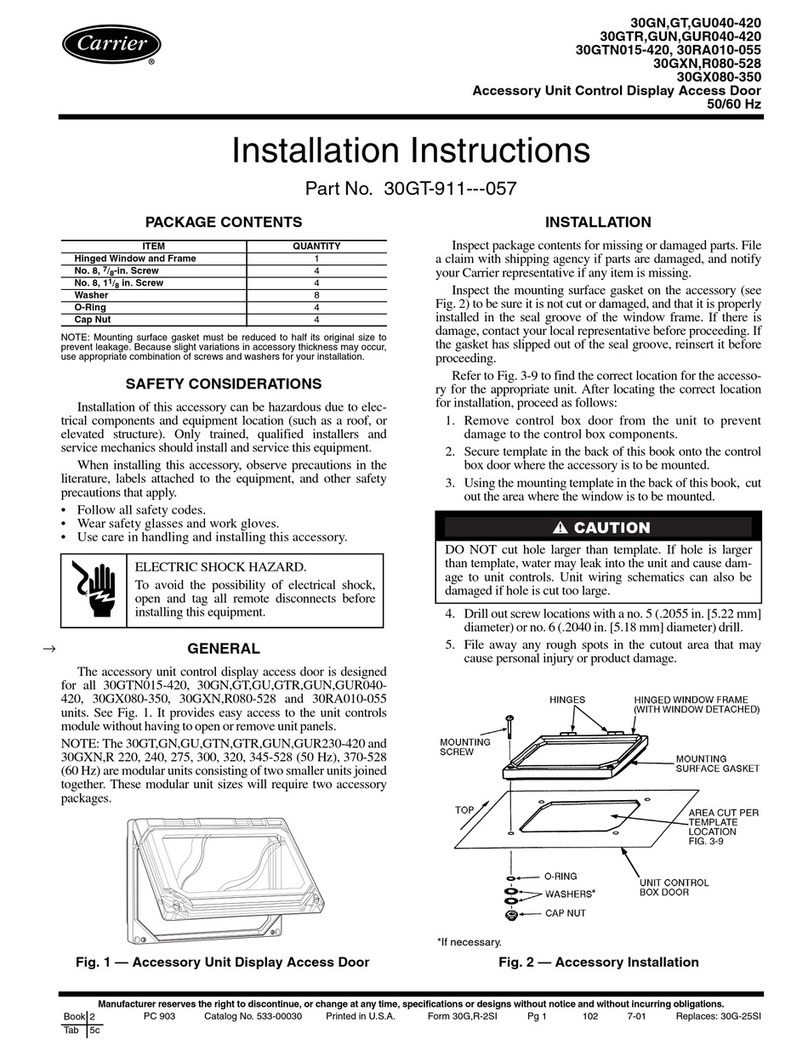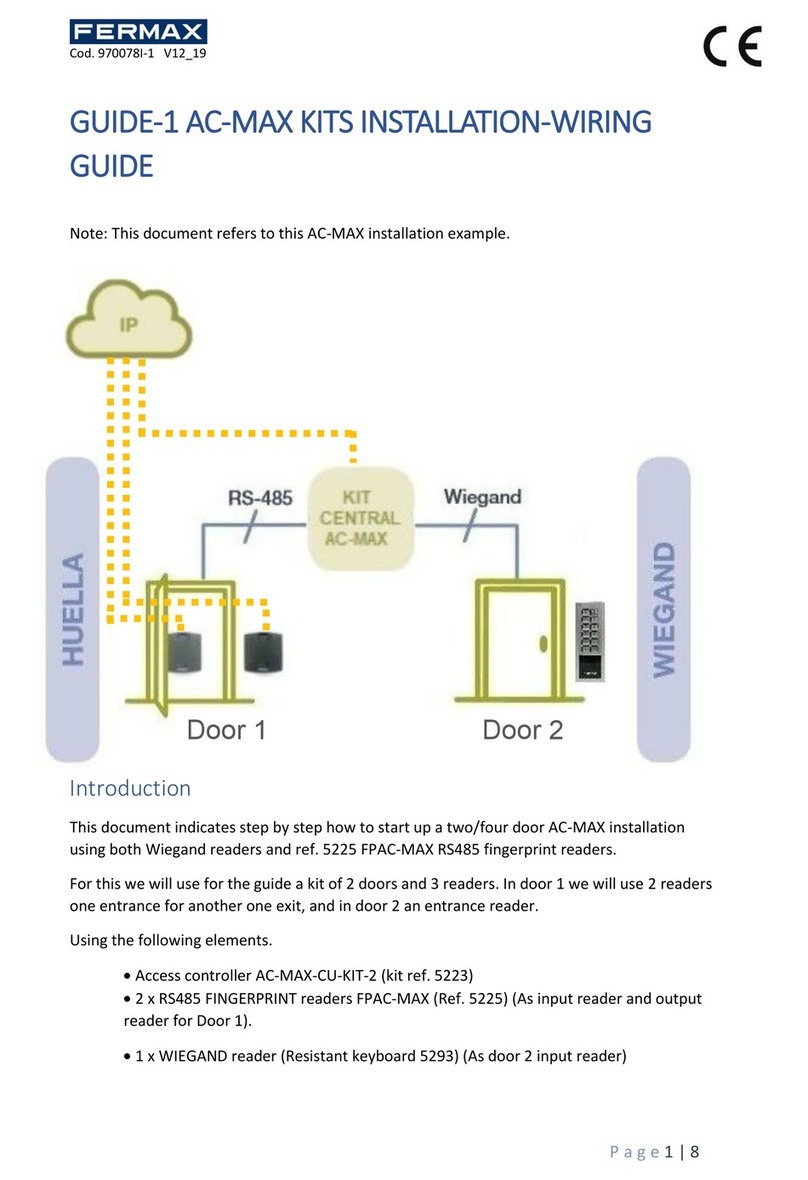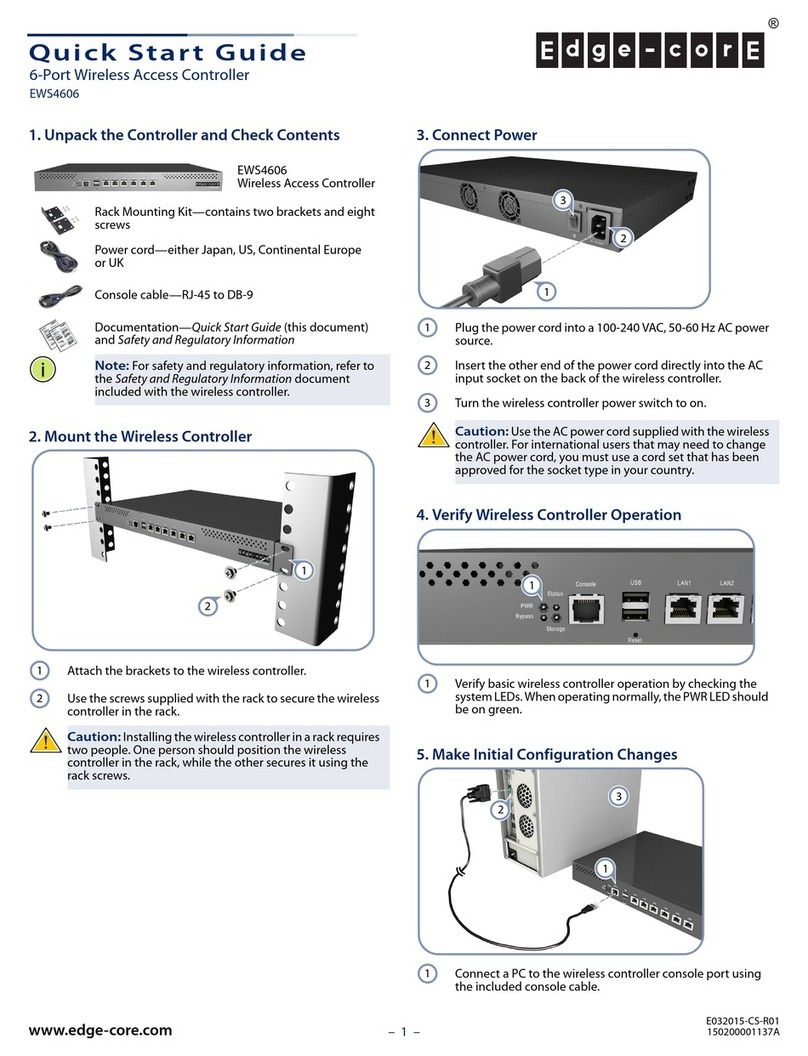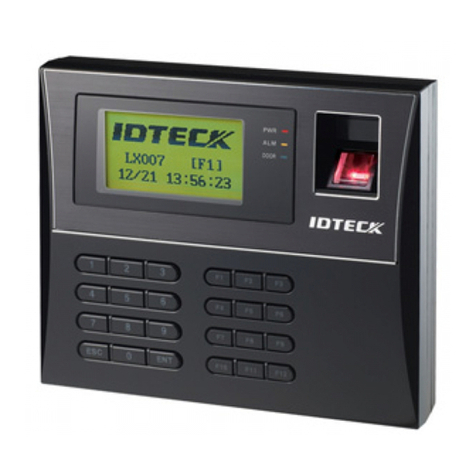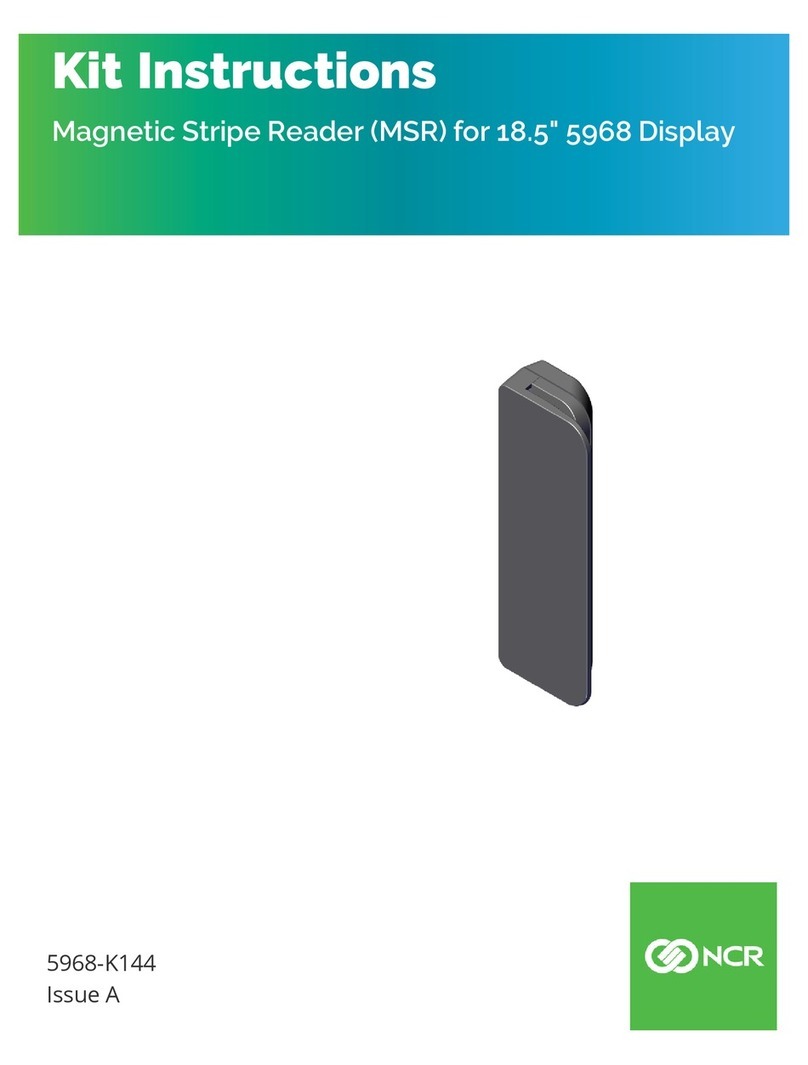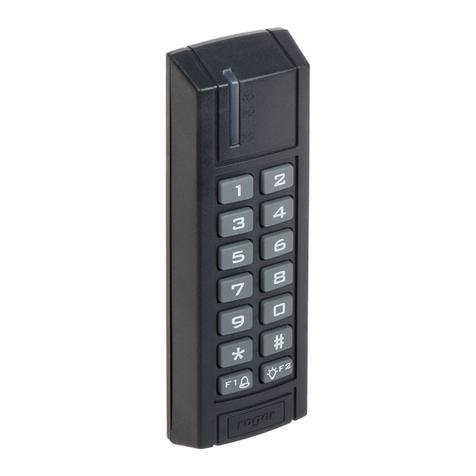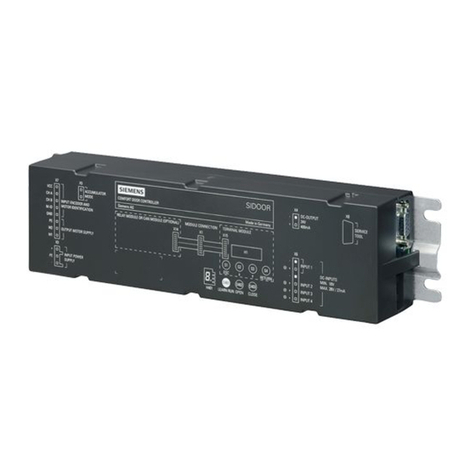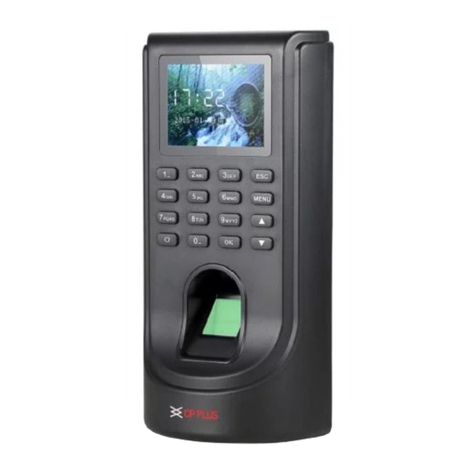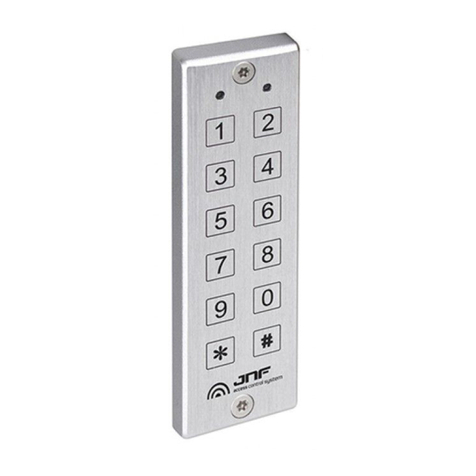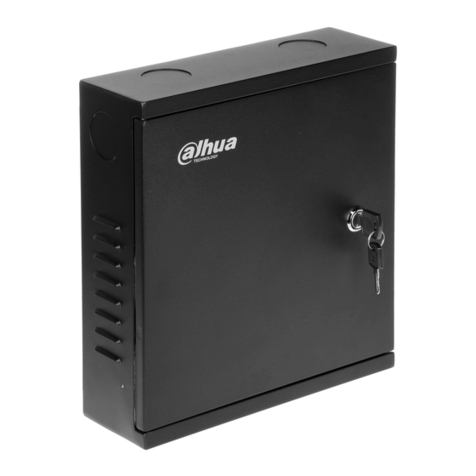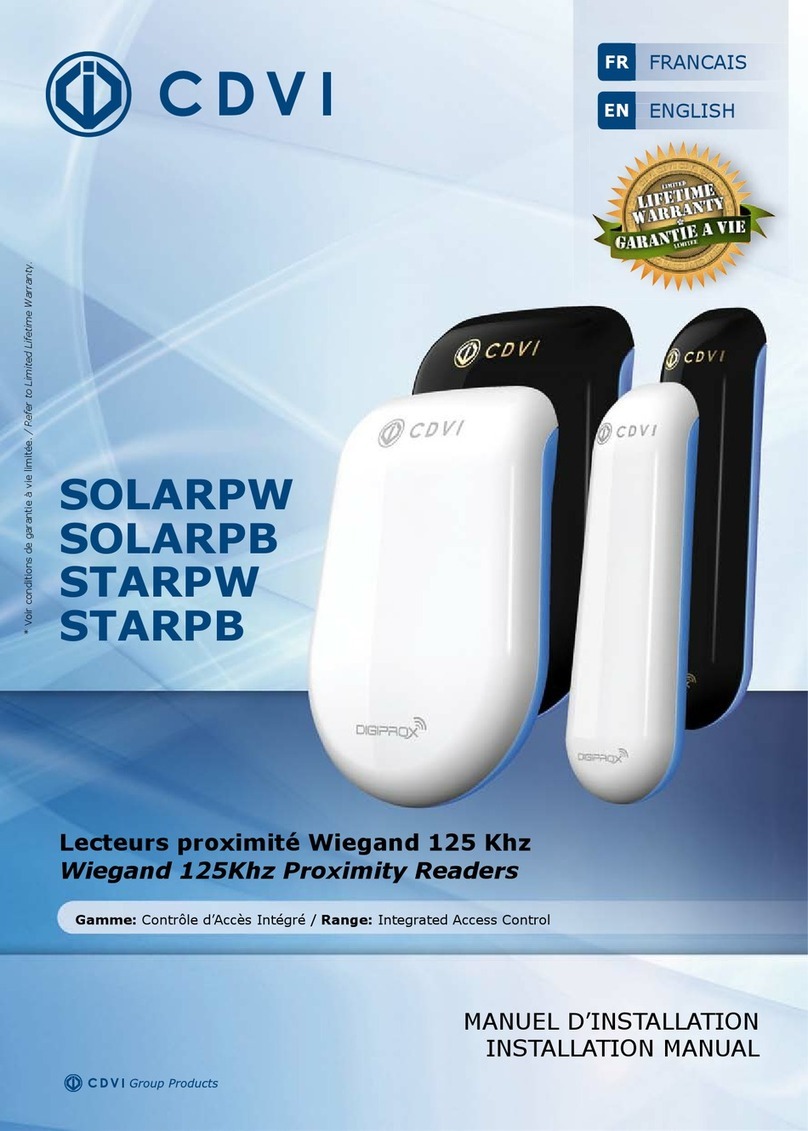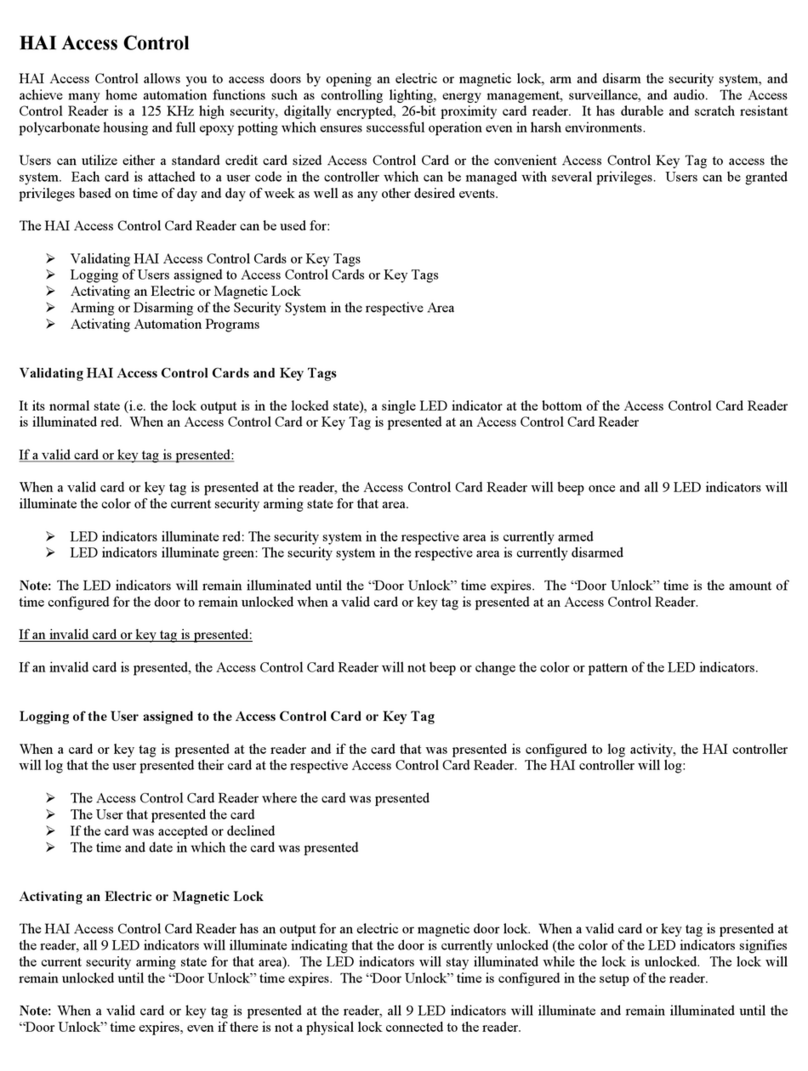Software House PSX Series User manual

www.swhouse.com
.
PSX RACKMOUNT
INSTALLATION AND OPERATION
PSX-ISU-RD
PSX-ISUSE-RD
PSX-GCM-RB
P03-032 revAO7

ii
PSX Rackmount Power Supply - Installation and Operation Manual
Table of Contents ........................................ii
Notes and Warnings ........................................................... iii
Symbol Definitions ............................................................ iii
Warnings.................................................................... iii
Regulatory Information ......................................................... iii
Conventions Used Within this Manual.............................................. iii
Introduction............................................iv
Section 1 – Installation ....................................1
1.1 Mounting the Rack Mount Supply into a Standard 19" Rack ...........................1
1.2 PSX Rackmount Power Supply Overview .........................................2
1.3 Internal Pre-Configuration.....................................................4
1.4 Making the Wiring Connections . . . . . . . . . . . . . . . . . . . . . . . . . . . . . . . . . . . . . . . . . . . . . . . .6
1.5 FAI Connections ............................................................7
Section 2 – Power and Network Connections .....................8
2.1 Main AC Power Connection....................................................8
2.2 Remote Access via Ethernet ...................................................8
Section 3 – Configuration and Usage........................... 9
3.1 Removing the Faceplate of the Enclosure.........................................9
3.2 Configuring the Zones - PSX-ISUSE.............................................9
3.3 Configuring the Zones - PSX-ISU..............................................10
3.4 Disabling Faults - PSX-ISU...................................................10
3.5 Status LEDs - PSX-ISUSE ...................................................11
3.6 Status LED - PSX-ISU ......................................................11
3.7 Remote Access via Ethernet (All models)........................................11
Section 4 – Specifications ................................. 12
4.1 Electrical Specifications .....................................................12
4.2 Temperature Specifications ..................................................14
4.3 Mechanical Specifications ...................................................14
Table of Contents

iii
Notes and Warnings
Symbol Definitions
The following symbols are used throughout this manual
hThis symbol is intended to alert the installer of shock
hazards within the enclosure. Service should only be
performed by qualified service personnel
iThis symbol is intended to alert the installer of im-
portant information intended to help the installer
avoid personal injury or property damage
Warnings
hInstallation and service should be performed only by
qualified service personnel and should conform to
all local codes
h
To reduce the risk of electric shock or fire, do not
expose this equipment to rain or moisture
i
This equipment shall be installed in a manner which
prevents unintentional operation by employees,
cleaning personnel, or others working in the prem-
ises, by falling objects, customers, building vibra-
tion, or similar causes
i
This equipment is not intended for use within the pa-
tient care areas of a Health Care Facility
h
Replace fuses only with the same type and rating as
indicated in the specifications section of this manual.
i
To prevent impaired operation, ensure that all wiring
is routed and secured to prevent accidental open or
short circuit conditions
i
The system and any batteries (if used) should be test-
ed at least once per year to ensure proper operation.
Regulatory Information
The equipment discussed within this manual has been test-
ed to the following standards:
• UL294, UL603, UL864, UL1076, UL1481,
UL2044, UL2572
• ULC S318, ULC S319, ULC S527
• CSA C22.2 #107.1, CSA C22.2 #60950
FCC Information
Note: This equipment has been tested and found to comply
with the limits for a Class A digital device, pursuant to Part
15 of the FCC Rules. These limits are designed to provide
reasonable protection against harmful interference when
the equipment is operated in a commercial environment.
This equipment generates, uses, and can radiate radio fre-
quency energy and, if not installed and used in accordance
with the instruction manual, may cause harmful interfer-
ence to radio communications. Operation of this equipment
in a residential area is likely to cause harmful interference in
which case the user will be required to correct the interfer-
ence at his own expense
Conventions Used Within this Manual
Positional information (e.g. top, bottom, up, down, left,
right, etc.) is referenced with the board or enclosure in the
orientation shown in the illustrations in this manual

iv
PSX Rackmount Power Supply - Installation and Operation Manual
Introduction
PSX Models Power Outputs Description
PSX-GSM-RB 75W 2 Single Voltage 6A @ 12VDC (SYSTEM)
PSX-ISU-RD 400W 2 Dual Voltage 12A @ 12VDC (SYSTEM) 10A @ 24VDC (LOCK)
PSX-ISU-RDN 400W 2 Dual Voltage 12A @ 12VDC (SYSTEM) 10A @ 24VDC (LOCK) NETWORK
PSX-ISUSE Power Outputs Description
PSX-ISUSE-RD 400W 16 Dual Voltage 12A @ 12VDC (SYSTEM) 10A @ 24VDC, 16 LOCK OUTPUTS
PSX-ISUSE-RDN 400W 16 Dual Voltage 12A @ 12VDC (SYSTEM) 10A @ 24VDC, 16 LOCK OUTPUTS, NETWORK
The PSX rackmount series of power supplies provide DC
power for lifesafety applications. Designed to fit neatly into
standard 19" equipment racks, the streamlined cabinetry
and exceptional features combine to significantly reduce
installation and service costs. Features include removable
terminal strips for field wiring, input and output surge sup-
pression, automotive blade fuses for improved reliability,
and is enclosed in a 16 gauge steel 2U rack mount chassis.
Product Description
The PSX-ISUSE rackmount series for iSTAR ULTRA SE
provides 12 and/or 24 VDC power at 400W of total power with
16 individual lock control outputs. PSX-ISUSE is available
with optional network monitoring: PSX-ISUSE-RDN model.

1
Installation and Operation
Use the following procedure when mounting an PSX series
supply into a standard EIA 19" equipment rack.
1. Ensure any internal configuration (voltage selection, fault
detection settings, etc) are complete before mounting.
See Section 1.3 of this manual for more information.
2. Securely mount the included ears to the enclosure sides
using the eight included 6-32 countersunk screws (four
per ear).
3. Locate the rack-mounting holes in the ears of the en-
closure. (Figure 1)
4. Slide the enclosure into an open 2U location in the rack
5. Center the enclosure in the rack and secure with the
four 10-32 x 3/4" screws provided.
NOTE: Use rails or other appropriate support for heavy
enclosures. Keep heavier components near the bottom of
the rack to reduce the risk of toppling of a top-heavy rack.
NOTE: For UL864 Installations, the Rack Mount Supply
must be mounted in an ENCLOSED rack where the field
wiring will be protected.
1.1 Mounting the Rack Mount Supply into a Standard 19" Rack
The following pages cover the installation of the PSX Series rack-mountable power supplies.
Section 1 – Installation
Figure 1 - The Enclosure Mounting Holes

2
PSX Rackmount Power Supply - Installation and Operation Manual
1.2 PSX Rackmount Power Supply Overview
AC Power
10-100
Base-T
9
A B
10
A B
11
A B
12
A B
13
A B
14
A B
15
A B
16
A B
9
A B
10
A B
11
A B
12
A B
13
A B
14
A B
15
A B
16
A B
MAIN OUTPUT 1
BAT+
BAT-
DC1 +
DC1 -
DC2 +
DC2 -
ACF
ACF
V +
V -
I -
I -
V -
I -
SF
SF
MAIN OUTPUT 2
BAT+
BAT-
DC1 +
DC1 -
DC2 +
DC2 -
ACF
ACF
V +
V -
I -
I -
V -
I -
SF
SF
1
A B
2
A B
3
A B
4
A B
CONTROLLED OUTPUTS 1 CONTROLLED OUTPUTS 2
CONTROL INPUTS 1 CONTROL INPUTS 2
5
A B
6
A B
7
A B
8
A B
9
A B
10
A B
11
A B
12
A B
13
A B
14
A B
15
A B
16
A B
CH1 CH2 CH3 CH4 CH5 CH6 CH7 CH8
FLT
3
3
3
3
3
3
3
3
3
CH1 CH2 CH3 CH4 CH5 CH6 CH7 CH8
FLT
3
3
3
3
3
3
3
3
3
CH1 CH2 CH3 CH4 CH5 CH6 CH7 CH8
FLT
3
—
3
3
3
3
3
3
3
3
CH1 CH2 CH3
VOLTAGE SELECT JUMPERS
DC1
DC2
CH4 CH5 CH6 CH7 CH8
FLT
3
3
3
3
3
3
3
3
1
ON
23 4 5 6 87
CH1 CH2 CH3 CH4 CH5 CH6 CH7 CH8
FLT
3
3
3
3
3
3
3
3
1
ON
23 4 5 6 87
CH1 CH2 CH3 CH4 CH5 CH6 CH7 CH8
FLT
3
3
3
3
3
3
3
3
1
ON
23 4 5 6 87
A B
CONTROLLED OUTPUTS
CONTROL INPUTS
1
+
2 3 4
-+-+-+-
5
+
6 7 8
1 2 3 4 5 6 7 8
-+-+-+-
A B A B A B A B A B A B
A B
1
ON
23 4 5 6 871
ON
ON ON ON ON
23 4 5 6 87
N.O. INPUT
N.C. INPUT
Enable FAI
Disable FAI
Fail-Safe OUTPUT
Fail-Secure
OUTPUT
AC Power
10-100
Base-T
ACF
ACF
DC2 –
DC2 +
BAT –
SF
SF
L
L
V –
I –
I +
V +BAT +
DC1 –
DC1 +
MAIN OUTPUT 2
SF
SF ACF
ACF
DC2 –
DC2 +
BAT –
L
L
V –
I –
I +
V +BAT +
DC1 –
DC1 +
MAIN OUTPUT 1
PSX-ISUSE
PSX-GCM / PSX-ISU
CH1 CH2 CH3 CH4 CH5 CH6 CH7 CH8 CH1 CH2 CH3 CH4 CH5 CH6 CH7 CH8
CH1 CH2 CH3 CH4 CH5 CH6 CH7 CH8
FLT
1
2
3
4
5
6
7
8
3
3
3
3
3
3
3
3
—
1
B1 B2
JP1
2 3
CH1 CH2 CH3 CH4 CH5 CH6 CH7 CH8
FLT
1
2
3
4
5
6
7
8
3
3
3
3
3
3
3
3
—
1
B1 B2
JP1
2 3
CH1 CH2 CH3 CH4 CH5 CH6 CH7 CH8
FLT
1
2
3
4
5
6
7
8
3
3
3
3
3
3
3
3
—
1
B1 B2
JP1
2 3
CH1 CH2 CH3 CH4 CH5 CH6 CH7 CH8
FLT
1
2
3
4
5
6
7
8
3
3
3
3
3
3
3
3
—
1
B1 B2
JP1
2 3

3
Installation and Operation
1Main AC Power Switch / Circuit Breaker
This is the main AC power switch for the enclosure. This switch
lights when power is on and also has a built-in circuit breaker rated
at 8A. If the circuit breaker trips, reset it by cycling the switch to off
then back to on.
2AC Line Input
This is the connector for the AC line cord. Plug the included computer-
style line cord into this connector. Connect the other end of the cord to
the power strip inside the rack or another suitable AC power receptacle.
iThe PSX Series is preconfigured for a 120VAC input. See sec-
tion 1.3.2 to set for a 230VAC input.
3Ethernet Connection
This is the RJ45 jack for the network connection for the internal NetLink
board (if present). The ethernet cable is plugged into this jack. This jack
is only present on PSX series power supplies with a model number end-
ing in "N". See Section 2.2 and the corresponding NetLink manual for
more information.
4Field Wiring
These terminals provide the field wiring connections. Terminal
quantity and function varies based on configuration and the func-
tion is marked adjacent to each terminal. All rear terminal blocks
may be secured with the screw on either end of the block. These
terminals all accept AWG 12-22.
• (PSX-ISUSE only) Controlled Outputs 1&2 — These are the
zone outputs. The PSX-ISUSE has 16 outputs. The output num-
bers correspond with the output zone numbers on the front panel.
See Section 1.4.1 for more information.
• (PSX-ISUSE only) Control Inputs 1&2 — These terminals are
the inputs which control the corresponding outputs. These in-
puts accept a NO or NC dry contact, voltage, or open collector
(transistor) input. See #10 for configuring input type.
• Bat(±) — This is where the battery connection is made. The
voltage of the battery set must match the voltage of the associ-
ated power supply. Dual power supply models will have two
independent battery connections. See Section 1.41 for more
information.
• DC1(±) —This is a bulk power output with the full power of
the associated power supply available on these terminals. Dual
power supply models will have two DC1 outputs. See Section
1.4.1 for more information.
• DC2(±) —This is an FAI-controllable bulk power output with
the full power of the associated power supply available on these
terminals. Dual power supply models will have two DC2 outputs.
See Section 1.4.1 for more information.
• ACF & SF — These terminals accept the optional FAI input for
controlling the DC2 outputs and any controlled output which has
FAI control enabled. See Section 1.4.1 for more information.
• V+, I+, I–, V–, L, L —These terminals accept the optional FAI
input for controlling the DC2 outputs. See Section 1.4.1 for
more information.
5Bus Selection
These jumpers select the output voltage for each output in dual voltage
systems. Single voltage systems should leave these jumpers in the DC1
(UP) Position. For dual voltage systems, selection is as follows:
• DC1 (UP) - Power Supply 1
• DC2 (DOWN) - Power Supply 2
6Output Fuses
These are the fuses for each zone output. Each fuse corresponds to
the zone LED below it.
7Fault Status LED (YELLOW)
This LED lights when the front board detects a fault condition. Fault
conditions reported by this LED include ruptured output fuse(s) or
improperly configured jumpers or switches. This LED does not in-
dicate problems with the internal power supply. See Section 3.3 for
more information.
8
Output Status LEDs (GREEN)
These LEDs indicate the status of the zone’s output.
PSX-ISUSE When Powering Lock Devices:
•OnSteady-DoorLocked(FuseorPTCIntact)
•Off-Fuserupturedorjumpermissing
•Flashing-DoorunlockedduetoinputorFAI
PSX-ISU
•OnSteady-VoltageAvailableatOutput
•Off-Fuserupturedorjumpermissing
9Fault Disable Switches (PSX-ISU only)
These switches disable fault detection by individual zone. This
allows removal of the fuse for unused zones without causing a
fault condition. See Section 2.3 for more information.
bk Output Selection (Front Board) PSX-ISUSE only
These switches are used to select a fail-safe or fail-secure output for
each zone. Switch 1 sets zone 1, switch 2 sets zone 2, and so on.
Set this switch so that the door is UNLOCKED when the zone output
LED is flashing (Zone Active).
• ON (FAIL SECURE Output) By setting this switch to ON, the
zone's output terminals will output a voltage when the zone
input is activated.
• OFF (FAIL SAFE Output) By setting this switch to OFF, the
zone's output terminals will output a voltage when the zone in-
put is NOT active. This position is typically used for Mag Locks.
bl Input Selection (Rear Board) PSX-ISUSE only
These switches are used to select a normally open or normally
closed input for each zone. Switch 1 sets zone 1, switch 2 sets zone
2, and so on. Adjust this switch so that the zone's output LED is
FLASHING when the door is unlocked.
• OFF (NC/Fail Safe) Set this switch to OFF for a NC contact input
(contact OPENS to unlock door) or for a voltage input where the
voltage is REMOVED to unlock the door.
• ON (NO/Fail Secure) Set this switch to ON for a NO contact
input (contact CLOSES to unlock door) or for a voltage input
where the voltage is APPLIED to unlock the door.
bm FAI Selection (Rear Board) PSX-ISUSE only
These switches enable or disable FAI for the selected zone. Switch
1 sets zone 1, switch 2 sets zone 2, and so on.
• ON (FAI Enabled) When this switch is set to ON, the zone's
output will invert when the FAI input is active. This is typically
used to drop power to maglocks on a fire alarm condition.
• OFF (FAI Disabled) When this is set to OFF, FAI will have no
effect on the zone's output.
The following are basic descriptions. Refer to the appropriate section for more detailed information. Note that the front and
back panels may appear different based on the configuration of your system.

4
PSX Rackmount Power Supply - Installation and Operation Manual
Configuration internal to the rack mount enclosure is re-
quired on PSX series power supplies prior to installation
into a rack.
1.3.1 Removing the Top Cover of the Enclosure
Use the following steps to remove the top cover of the rack-
mount enclosure and gain access to the configurable settings.
(Figure 2)
1. Lay the enclosure flat on its bottom surface
2. Remove and retain the six philips head screws from
the top cover
3. Remove the top cover and set it aside in a safe location
When configuration is complete, reverse the removal pro-
cedure to replace the cover.
Figure 2 - The Top Cover Mounting Screws
1.3.2 Configuring for a 230VAC Input Voltage
The PSX series is factory set for a 120VAC input. If the PSX
is to be used with a 230VAC input, jumper JP1 must be cut on
ALL PSX power supplies internal to the PSX. (Figures 3 and 4).
See the PSX manual for more information.
i Failure to cut JP1 on both supplies when connecting to a
230VAC input will damage the system and void the warranty.
1.3.3 Setting the Output Voltages
The PSX series will contain one or two internal power sup-
plies, depending on model. The voltage may be set on each
PSX power supply for 12 or 24VDC .
After removing the top cover, set the output voltage of the
PSX power supplies by moving SW1 to either 12V or 24V
(See #3 in Figure 3).
See the PSX manual for more information on setting the
output voltage.
1.3.4 Enabling or Disabling Battery Presence Detection
Each PSX power supply may be set to detect a missing
battery set. To enable battery presence detection, place the
BATDET jumper ON. To disable battery presence detection,
remove the BATDET jumper, or place it on only one pin.
(See #2 in Figure 3)
1.3.5 Enabling or Disabling Earth Ground Detection
Each PSX power supply is able to detect earth ground
faults. To enable earth ground fault detection, place the
EARTH GND DET jumper ON. To disable earth ground fault
detection, remove the EARTH GND DET jumper or place it
on only one pin. (See #1 in Figure 3)
NOTE: Only one device in a system should have earth
ground fault detection enabled or conflicts may occur. In
addition, only ONE PSX power supply in a dual-supply PSX
system should have earth ground fault detection enabled or
a conflict may occur.
1.3.6 Changing the Operation of the Fault Contact Output
From the factory, PSX series supplies are shipped with a
normally open fault contact operation (relay contact closed
until a fault occurs).
This operation may be switched to a normally closed con-
tact (relay contact open until a fault occurs) by moving a
wire on each fault contact.
To switch from the default NO fault contact to a NC contact,
locate the fault output terminal strip on the PSX power sup-
ply. Identify the contact you want to change (SYS FLT or AC
FLT), loosen the terminal, remove the wire from the NO ter-
minal, move it to the NC terminal, and tighten the terminal.
NOTE: This must be done on BOTH power supplies in dual-
supply models.
1.3.7 Changing the FAI Operation
The DC2 output may be set to either power up when an FAI
is received or to drop power when an FAI is received by
changing the position of the DC2 fuse on the PSX board.
• DC2 NO Position - DC2 output has no voltage until a
valid FAI input signal is received.
• DC2 NC Position - DC2 output has voltage present in
the normal state. This voltage goes away when a valid
FAI input signal is received.
1.3 Internal Pre-Configuration

5
Installation and Operation
PSX-150
PSX-250
PSX-75
Earth GND
Battery DETECT
Voltage SELECT
230VAC jumper
Figure 3 - Configuring the Internal PSX Power Supplies in a Rackmount System
Figure 4 - PSX 230VAC jumper location
AC Input
cut jumper
for 230VAC
cut jumper
for 230VAC
AC ON
AC Input
AC ON
PSX-150, 250
PSX-75

6
PSX Rackmount Power Supply - Installation and Operation Manual
Field wiring connections are made on the rear panel after installing
the PSX enclosure into the rack. Field wiring connections are made
to the removable terminal strips, which accept AWG 12-22 wire. The
back panel is also where the main AC power and optional ethernet
connections are made.
1.4.1 Field Wiring
The PSX Rackmount series has terminals for various inputs
and outputs as follows:
Controlled Outputs - PSX-ISUSE only
These terminals provide the distributed, controlled outputs
to the load devices. Depending on model, there will be ei-
ther 8 or 16 output zones. The output zone numbers will
correspond with the numbering of the zones on the front
panel. Polarity is indicated adjacent to each terminal. The
output is configured by setting the front and rear panel
jumpers and switches.
Control Inputs - PSX-ISUSE only
These are the zone input terminal strips. The terminals are
labeled on the back panel near the terminal strip.
•Whenusingadrycontactinput,thecontactisconnected
across the A and B terminals. When configured for a dry
contact input, it is normal to measure a voltage across
these two terminals. This voltage is current limited and will
not damage the activation contact.
•Whenusingavoltageinput,thevoltageisconnectedto
the B terminal. The activation voltage must be common
grounded with the system voltage. The activation voltage
must be between 12 and 24VDC nominal. Do not connect
anything to the A terminal of the input.
•Whenusinganopencollector(transistor)input,placea
jumper across the A and B terminals and connect the open
collector to the B terminal. Note that the input source must
be common grounded with the enclosure power source.
Battery (Bat+, Bat–)
This pair of terminals is for connection to a backup battery set, if
required for the installation. Polarity is noted adjacent to the termi-
nals. These terminals also charge the battery set.
NOTE: Observe polarity or damage to the system will occur.
Ensure the voltage of the battery set matches the voltage of
the power supply.
NOTE: It is the installer's responsibility to determine the prop-
er battery size for the installation. See the Specifications sec-
tion for battery standby current requirements.
DC1+, DC1–
The main DC output of the PSX power supply. The full cur-
rent of the PSX is available on these terminals at all times
and is unaffected by the FAI input.
DC2+, DC2–
The DC2 output may optionally be controlled by the FAI in-
put. The full current of the PSX is available on these termi-
nals. The DC2 output may be set to power up when an FAI
signal is received or to drop power when an FAI signal is
received by changing the position of the DC2 fuse on the
PSX before installing the PSX into the rack.
AC Fault (ACF)
These terminals provide the AC Fault relay output from the
PSX power supply. This relay signals when the internal PSX
power supply detects a low or missing AC input voltage.
From the factory this output is set to provide a CLOSED
connection when there is no fault. During a fault condition,
the connection between these terminals will OPEN.
To reverse this operation, see Section 1.3.6 of this manual.
System Fault (SF)
These terminals provide the System Fault relay output
from the PSX power supply. This relay signals when any
of the following conditions occur:
• Missing Battery (If BAT DET jumper is ON)
• Earth Ground Fault (If EARTH GND DET jumper is ON)
• Battery voltage out of range
• DC output voltage out of range
• Ruptured fuse
• Accessory Board Fault
• Internal Fault
From the factory this output is set to provide a CLOSED
connection when there is no fault. During a fault condition,
the connection between these terminals will OPEN.
To reverse this operation, see Section 1.3.6 of this manual.
FAI Input (V+, I+, I–, V–, L, L)
These terminals accept the optional FAI / Access Control
input for controlling the outputs. See FAI Input Usage dia-
grams on next page for more information.
Connections are as follows:
• L Terminals Latch Reset contact input. If a latching FAI In-
put is desired, a normally closed contact is placed across
these terminals. When the FAI Input is activated, it will
latch in the activated state until this contact is momentarily
opened. If the latching feature is not desired, leave these
terminals open.
• V+ & V– Terminals These terminals are a low-current aux-
iliary voltage output to be used with a dry contact or open
collector for activating the FAI Input.
• I+ & I– Terminals These terminals are the input terminals
for the FAI Input. The FAI input is activated when a voltage
between 9 and 30 volts is applied across these terminals in
the correct polarity.
1.4 Making the Wiring Connections

7
Installation and Operation
1.5 FAI Connections
This section provides more detailed information on the connection and usage of the FAI input.
Activation with a Normally Open Relay Contact
FAI Activates when the
NO contact CLOSES.
FAI Deactivates when the
NO contact OPENS.
Activation with a Normally Closed Relay Contact
FAI Activates when the
NC contact OPENS.
FAI Deactivates when the
NC contact CLOSES.
Note: FAI with a NC contact
cannot be tested by removing
the terminal strip, as this will
remove the jumper wires from
V+ and V- as well. To test,
remove one wire going to the
NC Contact.
Activation with a Voltage Input
FAI Activates when voltage is
APPLIED in the correct polarity.
FAI Deactivates when voltage is
REMOVED or the polarity of the
voltage is REVERSED. Polarity
shown in the ACTIVATED state
Latching the FAI Input
Latching of the FAI Input
is achieved by placing a
NC contact across the
two ‘L’ terminals. The FAI
may be activated by any
of the methods listed.
FAI Deactivates when the
input is deactivated AND
the NC Latching contact is
momentarily OPENED.
Example – NO Contact
activation with latching
FAI Activates when the NO contact CLOSES. FAI Deactivates
when the NO contact OPENS AND the NC contact momentarily
OPENS.
FAI Activation with a Normally Open Relay Contact
and PSX AC Fault Lock Over Ride
FAI Activates either, when the Fire Alarm NO contact CLOSES,
or when the AC Fault NC contact CLOSES
FAI Deactivates either, when the Fire Alarm NO contact OPENS,
or when the PSX AC Fault NC contact OPENS
SYS ACSYS AC
FAULTSFAULTS
FAI
INPUT
CC NCNC NONO CC NCNC NONO
FAI INPUTFAI INPUT
LL LL V–V– I–I– I+I+ V+V+
FAI INPUTFAI INPUT
LL LL V–V– I–I– I+I+ V+V+
NO
Contact
NC
Contact
FAI INPUTFAI INPUT
LL LL V–V– I–I– I+I+ V+V+
9-30 VDC
–
+
FAI INPUTFAI INPUT
LL LL V–V– I–I– I+I+ V+V+
NO
Contact
NC
Contact
FAI INPUTFAI INPUT
LL LL V–V– I–I– I+I+ V+V+

8
PSX Rackmount Power Supply - Installation and Operation Manual
Section 2 – Power and Network Connections
2.2 Remote Access via Ethernet
PSX Series power supplies with model numbers ending in
"N" may be accessed over the internet or local intranet via
the ethernet port on the back of the enclosure (Figures 5
and 6). Functionality varies by model type. This section only
gives basic information. See the PSX-NL manual for more
information.
Features available with the PSX-NL in a PSX rackmount
include monitoring and email reporting of voltage, bat-
tery status, AC and System Fault status and other pa-
rameters. Additionally, a periodic status report can be
emailed.
i The internal Netlink communication module must be
configured before connecting to a network.
See the PSX Netlink manual for more information.
Figure 5 - PSX-GCM, PSX-ISU AC Connection and Ethernet Network Connection
Figure 6 - PSX-ISUSE AC Connection and Ethernet Network Connection
AC Power
10-100
Base-T
9
+ –
10
+ –
11
+ –
12
+ –
13
+ –
14
+ –
15
+ –
16
+ –
9
A B
10
A B
11
A B
12
A B
13
A B
14
A B
15
A B
16
A B
MAIN OUTPUT 1
BAT+
BAT-
DC1 +
DC1 -
DC2 +
DC2 -
ACF
ACF
V +
V -
I -
I -
V -
I -
SF
SF
MAIN OUTPUT 2
BAT+
BAT-
DC1 +
DC1 -
DC2 +
DC2 -
ACF
ACF
V +
V -
I -
I -
V -
I -
SF
SF
1
+ –
2
+ –
3
+ –
4
+ –
CONTROLLED OUTPUTS 1 CONTROLLED OUTPUTS 2
CONTROL INPUTS 1 CONTROL INPUTS 2
5
+ –
6
+ –
7
+ –
8
+ –
1
A B
2
A B
3
A B
4
A B
5
A B
6
A B
7
A B
8
A B
2.1 Main AC Power Connection
To connect the PSX Series to the main AC power source, plug
one end of the included computer-style AC cord into the AC
Power connector on the back of the enclosure. See Figures 5, 6.
Connect the other end of the AC cord into a suitable AC
power outlet.
iThe PSX Series is preconfigured for a 120VAC input.
See section 1.3.2 to set for a 230VAC input.

9
Installation and Operation
This section describes the final configuration as well as operation details for the PSX series power supplies.
3.1 Removing the Faceplate of the Enclosure
Use the following steps to remove the faceplate of the rack-
mount enclosure and gain access to the front boards.
1. Remove and retain the five philips head 6-32 screws
from the faceplate. DO NOT remove the four 10-32
screws securing the enclosure to the rack.
2. Carefully remove the faceplate and set it aside in a
safe location
When configuration is complete, reverse the removal pro-
cedure to replace the cover, taking care to align the LEDs
with the holes in the faceplate (See figure 7).
3.2 Configuring the Zones - PSX-ISUSE
Input Selection (see Figure 8)
These switches are used to select a normally open or normally
closed input for each zone. Switch 1 sets zone 1, switch 2 sets
zone 2, and so on. Adjust this switch so that the zone's output
LED is FLASHING when the door is unlocked.
•OFF(NC/FailSafe) Set this switch to OFF for a NC contact
input (contact OPENS to unlock door) or for a voltage input
where the voltage is REMOVED to unlock the door.
•ON(NO/FailSecure) Set this switch to ON for a NO contact
input (contact CLOSES to unlock door) or for a voltage input
where the voltage is APPLIED to unlock the door.
FAI Selection (see Figure 8)
These switches enable or disable FAI for the selected zone.
Switch 1 sets zone 1, switch 2 sets zone 2, and so on.
•ON(FAIEnabled)When this switch is set to ON, the zone's
output will invert when the FAI input is active. This is typically
used to drop power to maglocks on a fire alarm condition.
•OFF(FAIDisabled) When this is set to OFF, FAI will have no
effect on the zone's output.
Output Selection (see Figure 9)
These switches are used to select a fail-safe or fail-secure out-
put for each zone. Switch 1 sets zone 1, switch 2 sets zone 2,
and so on. Set this switch so that the door is UNLOCKED when
the zone output LED is flashing (Zone Active).
•ON(FailSecureOutput) By setting this switch to ON, the
zone's output terminals will output a voltage when the zone in-
put is activated.
• OFF (Fail Safe Output) By setting this switch to OFF, the
zone's output terminals will not output a voltage when the zone
input is activated. This position is typically used for Mag Locks.
Section 3 – Configuration and Usage
A B
CONTROLLED OUTPUTS
CONTROL INPUTS
1
+
2 3 4
-+-+-+-
5
+
6 7 8
1 2 3 4 5 6 7 8
-+-+-+-
A B A B A B A B A B A B A B
1
ON
23 4 5 6 871
ON
23 4 5 6 87
N.O. INPUT
N.C. INPUT
Enable FAI
Disable FAI
2 3 4 5 6 7 8 F F1 10 11 12 13 14 15 169
Figure 8 - PSX-ISUSE Back Board
Figure 9 - PSX-ISUSE Front Board
Figure 7 - Faceplate
CH1 CH2 CH3 CH4 CH5 CH6 CH7 CH8
FLT
3
—
3
3
3
3
3
3
3
3
CH1 CH2 CH3
VOLTAGE SELECT JUMPERS
DC1
DC2
Fail-Safe
OUTPUT
Fail-Secure
OUTPUT
CH4 CH5 CH6 CH7 CH8
FLT
3
3
3
3
3
3
3
3
1
ON
23 4 5 6 87

10
PSX Rackmount Power Supply - Installation and Operation Manual
3.3 Configuring the Zones - PSX-ISU
Each output zone is configurable for one of two selections
which vary by model type. Selections are made by moving the
zone's corresponding jumper (marked as B1 and B2 on the PC
Board). See Figure 10
Single Supply Models
Each output is configurable for continuous or FAI con-
trolled. To set the operation of the FAI controlled outputs,
see Section 1.3.6.
• B1 (Left) Continuous Output (No FAI control)
• B2 (Right) FAI Controlled Output
Dual Supply Models
Each output is configurable for either internal power supply.
PSX#1 is the power supply on the left when looking from
the front and PSX#2 is the power supply on the right.
FAI control is provided on any distributed outputs set for
PSX#2 and the DC2 terminals of both PSX power sup-
plies.
• B1 (Left) PSX PS #1
• B2 (Right) PSX PS #2
3.4 Disabling Faults - PSX-ISU
Sometimes it is desirable to disable fuse fault detection for
individual zones. This allows removal of the fuse for spe-
cific unused zones or zones with unfinished wiring.
Faults can be disabled via the block of switches on the top
right of each front board (See Figure 2.2). Note that the
color of this switch block may vary. Switch numbers cor-
respond with zone numbers of the board (Switch 1 disables
faults for Zone 1, etc.). Switch settings are as follows:
• ON Fault Detection Enabled
• OFF Fault Detection Disabled
Figure 10 - PSX-ISU Front Board
CH1 CH2 CH3 CH4 CH5 CH6 CH7 CH8
FLT
1
2
3
4
5
6
7
8
3
3
3
3
3
3
3
3
—
1
B1 B2
JP1
2 3

11
Installation and Operation
ACF
ACF
DC2 –
DC2 +
BAT –
SF
SF
L
L
V –
I –
I +
V +BAT +
DC1 –
DC1 +
MAIN OUTPUT 2
9
+
10 11 12
-+-+-+-
13
+
14 15 16
-+-+-+-
9 10 11 12 13 14 15 16
A B
SF
SF ACF
ACF
DC2 –
DC2 +
BAT –
L
L
V –
I –
I +
V +BAT +
DC1 –
DC1 +
MAIN OUTPUT 1
CONTROLLED OUTPUTS
CONTROL INPUTS
1
+
2 3 4
-+-+-+-
5
+
6 7 8
1 2 3 4 5 6 7 8
-+-+-+-
A B A B A B A B A B A B A B A B A B A B A B A B A B A B A B
CONTROLLED OUTPUTS
CONTROL INPUTS
Figure 13 - Ethernet Network Connection
Figure 11 - PSX-ISUSE Front Board
Figure 12 - PSX-ISU Front Board
CH1 CH2 CH3 CH4 CH5 CH6 CH7 CH8
FLT
3
—
3
3
3
3
3
3
3
3
CH1 CH2 CH3
VOLTAGE SELECT JUMPERS
DC1
DC2
Fail-Safe
OUTPUT
Fail-Secure OUTPUT
CH4 CH5 CH6 CH7 CH8
FLT
3
3
3
3
3
3
3
3
1
ON
23 4 5 6 87
CH1 CH2 CH3 CH4 CH5 CH6 CH7 CH8
FLT
1
2
3
4
5
6
7
8
3
3
3
3
3
3
3
3
—
1
B1 B2
JP1
2 3
3.5 Status LEDs - PSX-ISUSE
Each front board has nine LEDs (see figure 11).
The eight green LEDs indicate the status of the zone’s output.
•OnSteady–Door Locked (Fuse or PTC Intact)
•Flashing–Door Unlocked (either due to Zone Input or FAI)
•Off–Fuse open or jumper missing
The yellow LED will light if a fault condition is detected by the
RC front board.
3.6 Status LED - PSX-ISU
Each front board has nine LEDs (see Figure 12). The eight
green LEDs give the voltage availability of the associated
zone. The yellow LED will light if a fault condition is detected.
3.7 Remote Access via Ethernet (All models)
PSX-N Series Rackmount power supplies use the optional Net-
Link board to allow access over the internet or local intranet via
the ethernet port on the back of the enclosure (see figure 13).
See the PSX NetLink manual for more information.

12
PSX Rackmount Power Supply - Installation and Operation Manual
Section 4 – Specifications
4.1 Electrical Specifications
Specifications PSX-GCM-RB PSX-ISU 150W PSX-ISU 250W
AC Input Voltage 120/230VAC
±15% at 50-60Hz
120/230VAC
±15% at 50-60Hz
120/230VAC
±15% at 50-60Hz
Power 100 Watts 200 Watts 300 Watts
Standby Current 100mA 100mA 100mA
Rated Current for UL603 Proprietary
Alarm Installations
Current 1.25A maximum from
all circuits in system
2.5A maximum from
all circuits in system
2.5A maximum from
all circuits in system
DC Output at 12V Setting Voltage 12.5V ±0.5V nominal 12.5V ±0.5V nominal 12.5V ±0.5V nominal
Max Current 6A 12A 20A
Ripple 120mV 120mV 120mV
Regulation ±2% ±2% ±2%
Efficiency 85% (120VAC
60Hz In, Full Load,
No Batt)
88% (120VAC
60Hz In, Full Load,
No Batt)
89% (120VAC
60Hz In, Full Load,
No Batt)
DC Output at 24V Setting Voltage 25.0V ±0.5V nominal 25.0V ±0.5V nominal 25.0V ±0.5V nominal
Max Current 3A 6A 10A
Ripple 120mV 120mV 120mV
Regulation ±2% ±2% ±2%
Efficiency 85% (120VAC
60Hz In, Full Load,
No Batt)
88% (120VAC
60Hz In, Full Load,
No Batt)
89% (120VAC
60Hz In, Full Load,
No Batt)
Battery Size & Type 4-40AH Lead Acid
or Gel Cell
4-80AH Lead Acid
or Gel Cell
4-80AH Lead Acid
or Gel Cell
Charge Current 1A (±10%) Maximum
(Adjustable via
PowerCom Software)
2A (±10%) Maximum
(Adjustable via
PowerCom Software)
2A (±10%) Maximum
(Adjustable via
PowerCom Software)
Fuse Ratings DC1 (Internal) ATM 7.5A ATM 15A ATM 30A
DC2 (Internal) ATM 7.5A ATM 15A ATM 30A
Battery (Internal) ATM 7.5A ATM 15A ATM 30A
BTU Output BTU 33 66 109
Fault Setpoints Low AC 95V (±6%) 95V (±6%) 95V (±6%)
Earth GND 2000 Ohms 2000 Ohms 2000 Ohms
Output Voltage ±10% of nominal ±10% of Nominal ±10% of Nominal
Batt Voltage ±10% of nominal ±10% of Nominal ±10% of Nominal
Batt Presence 6–15V (12V Setting),
11–29V (24V Setting)
6–15V (12V Setting),
11–29V (24V Setting)
6–15V (12V Setting),
11–29V (24V Setting)
Fault Relay Contacts AC FLT 1A at 24VDC 1A at 24VDC 1A at 24VDC
SYS FLT 1A at 24VDC 1A at 24VDC 1A at 24VDC

13
Specifications
Section 4 – Specifications
4.1 Electrical Specifications - continued
Specifications PSX-ISUSE 150W PSX-ISUSE 250W
AC Input Voltage 120/230VAC
±15% at 50-60Hz
120/230VAC
±15% at 50-60Hz
Power 200 Watts 300 Watts
Standby Current 100mA 100mA
Rated Current for UL603 Proprietary
Alarm Installations
Current 2.5A maximum from
all circuits in system
2.5A maximum from
all circuits in system
DC Output at 12V Setting Voltage 12.5V ±0.5V nominal 12.5V ±0.5V nominal
Max Current 12A 20A
Ripple 120mV 120mV
Regulation ±2% ±2%
Efficiency 88% (120VAC
60Hz In, Full Load,
No Batt)
89% (120VAC
60Hz In, Full Load,
No Batt)
DC Output at 24V Setting Voltage 25.0V ±0.5V nominal 25.0V ±0.5V nominal
Max Current 6A 10A
Ripple 120mV 120mV
Regulation ±2% ±2%
Efficiency 88% (120VAC
60Hz In, Full Load,
No Batt)
89% (120VAC
60Hz In, Full Load,
No Batt)
Battery Size & Type 4-80AH Lead Acid
or Gel Cell
4-80AH Lead Acid
or Gel Cell
Charge Current 2A (±10%) Maximum
(Adjustable via
PowerCom Software)
2A (±10%) Maximum
(Adjustable via
PowerCom Software)
Fuse Ratings DC1 (Internal) ATM 15A ATM 30A
DC2 (Internal) ATM 15A ATM 30A
Battery (Internal) ATM 15A ATM 30A
BTU Output BTU 66 109
Fault Setpoints Low AC 95V (±6%) 95V (±6%)
Earth GND 2000 Ohms 2000 Ohms
Output Voltage ±10% of Nominal ±10% of Nominal
Batt Voltage ±10% of Nominal ±10% of Nominal
Batt Presence 6–15V (12V Setting),
11–29V (24V Setting)
6–15V (12V Setting),
11–29V (24V Setting)
Fault Relay Contacts AC FLT 1A at 24VDC 1A at 24VDC
SYS FLT 1A at 24VDC 1A at 24VDC
Distributed Outputs
Count 16
Current Fused 3A
Current PTC 2.5A

14
PSX Rackmount Power Supply - Installation and Operation Manual
Section 4 – Specifications
4.2 Temperature Specifications
All Models
Ambient Temperature 0°C to 49°C (32°F to 120°F)
Ambient Humidity 93% at 32°C (90°F) maximum
Storage Temperature –30°C to 70°C (–22°F to 158°F)
4.3 Mechanical Specifications
Size (Without Ears)
Approximate Weight
17.5" W x 3.8" H x 14.0" D (445mm W x 97mm H x 356mm D)
Varies, based on configuration
co International Compan y
www.swhouse.com
The trademarks, logos, and service marks displayed on this document are registered in the United States [or other countries]. Any misuse of the trademarks is strictly prohibited and Tyco International Ltd. will aggressively
enforce its intellectual property rights to the fullest extent of the law, including pursuit of criminal prosecution wherever necessary. All trademarks not owned by Tyco International Ltd. are the property of their respective owners,
and are used with permission or allowed under applicable laws.
Product oerings and specications are subject to change without notice. Actual products may vary from photos. Not all products include all features. Availability varies by region; contact your sales representative.
© 2015 Tyco International Ltd. and its respective companies. All rights reserved.

15
User Certificate
co International Compan y
www.swhouse.com
The trademarks, logos, and service marks displayed on this document are registered in the United States [or other countries]. Any misuse of the trademarks is strictly prohibited and Tyco International Ltd. will aggressively
enforce its intellectual property rights to the fullest extent of the law, including pursuit of criminal prosecution wherever necessary. All trademarks not owned by Tyco International Ltd. are the property of their respective owners,
and are used with permission or allowed under applicable laws.
Product oerings and specications are subject to change without notice. Actual products may vary from photos. Not all products include all features. Availability varies by region; contact your sales representative.
© 2015 Tyco International Ltd. and its respective companies. All rights reserved.
This manual suits for next models
4
Table of contents
Other Software House IP Access Controllers manuals

